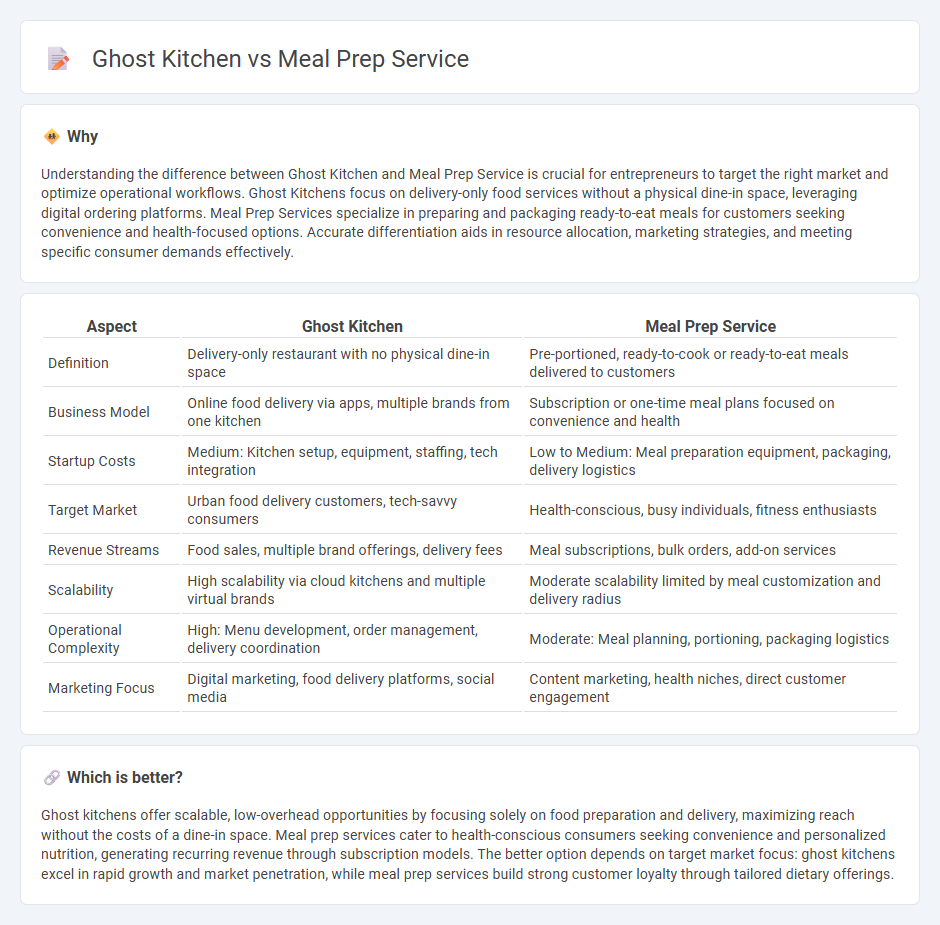
Ghost kitchens operate as delivery-only food establishments without a physical dine-in space, leveraging low overhead costs and technology to meet rising demand for convenience. Meal prep services focus on preparing and delivering ready-to-eat meals, targeting health-conscious consumers seeking time-saving nutrition solutions. Explore how these innovative business models reshape the entrepreneurship landscape and consumer food habits.
Why it is important
Understanding the difference between Ghost Kitchen and Meal Prep Service is crucial for entrepreneurs to target the right market and optimize operational workflows. Ghost Kitchens focus on delivery-only food services without a physical dine-in space, leveraging digital ordering platforms. Meal Prep Services specialize in preparing and packaging ready-to-eat meals for customers seeking convenience and health-focused options. Accurate differentiation aids in resource allocation, marketing strategies, and meeting specific consumer demands effectively.
Comparison Table
| Aspect | Ghost Kitchen | Meal Prep Service |
|---|---|---|
| Definition | Delivery-only restaurant with no physical dine-in space | Pre-portioned, ready-to-cook or ready-to-eat meals delivered to customers |
| Business Model | Online food delivery via apps, multiple brands from one kitchen | Subscription or one-time meal plans focused on convenience and health |
| Startup Costs | Medium: Kitchen setup, equipment, staffing, tech integration | Low to Medium: Meal preparation equipment, packaging, delivery logistics |
| Target Market | Urban food delivery customers, tech-savvy consumers | Health-conscious, busy individuals, fitness enthusiasts |
| Revenue Streams | Food sales, multiple brand offerings, delivery fees | Meal subscriptions, bulk orders, add-on services |
| Scalability | High scalability via cloud kitchens and multiple virtual brands | Moderate scalability limited by meal customization and delivery radius |
| Operational Complexity | High: Menu development, order management, delivery coordination | Moderate: Meal planning, portioning, packaging logistics |
| Marketing Focus | Digital marketing, food delivery platforms, social media | Content marketing, health niches, direct customer engagement |
Which is better?
Ghost kitchens offer scalable, low-overhead opportunities by focusing solely on food preparation and delivery, maximizing reach without the costs of a dine-in space. Meal prep services cater to health-conscious consumers seeking convenience and personalized nutrition, generating recurring revenue through subscription models. The better option depends on target market focus: ghost kitchens excel in rapid growth and market penetration, while meal prep services build strong customer loyalty through tailored dietary offerings.
Connection
Ghost kitchens and meal prep services intersect in the entrepreneurial landscape by leveraging shared infrastructure to maximize efficiency and reduce operational costs. Both models capitalize on delivery-focused food production without physical dine-in spaces, enabling rapid scalability and targeted market reach. Integrating meal prep services within ghost kitchens enhances menu variety and meets growing consumer demand for convenient, healthy meal solutions.
Key Terms
Business Model
Meal prep services operate on a direct-to-consumer subscription model offering pre-portioned, ready-to-eat meals that emphasize convenience and dietary customization. Ghost kitchens function as delivery-only food production facilities that partner with multiple restaurant brands or create virtual brands, minimizing overhead by eliminating dine-in services. Explore the distinct operational and revenue strategies that define these innovative food industry models.
Value Proposition
Meal prep services offer convenience through pre-portioned, chef-prepared meals tailored for time-strapped individuals seeking balanced nutrition and minimal effort. Ghost kitchens optimize delivery efficiency and menu variety without the overhead of a traditional restaurant, providing cost-effective, fast options to urban customers. Explore how these innovative food solutions redefine convenience and quality in modern dining.
Distribution Channel
Meal prep services primarily utilize direct-to-consumer distribution channels, relying on subscription models and home delivery to reach health-conscious individuals seeking convenience. Ghost kitchens leverage third-party delivery platforms and apps, optimizing order fulfillment by centralizing cooking in shared commercial spaces without dine-in options. Explore deeper insights into how these distribution strategies impact scalability and customer engagement.
Source and External Links
9 Best Meal Delivery Services for 2025: Tested by Us - This expert review compares top meal delivery services like Blue Apron, Sunbasket, Factor, and others by price, convenience, and health focus to help you pick the best meal prep service.
Home Chef: Meal Delivery Service - Fresh Weekly Meal Kit - Home Chef delivers fresh, pre-portioned ingredients with step-by-step recipes for easy home-cooked meals, offering options for individuals and families, with flexible delivery days.
EveryPlate: Get $1.99/meal Affordable Meal Kits Delivered to ... - EveryPlate is one of the most affordable meal kits starting at $5.99 per serving, offering simple, delicious meals delivered to your door and prepared in about 30 minutes.
 dowidth.com
dowidth.com